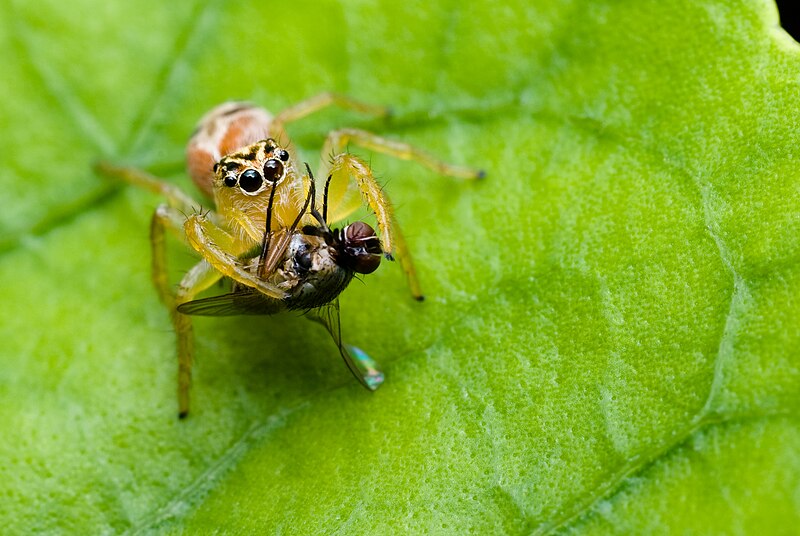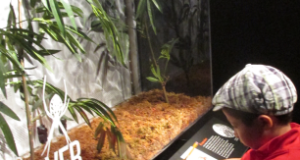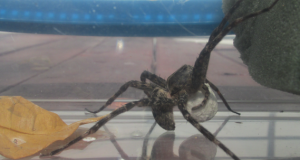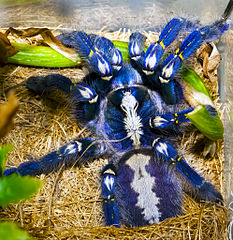 Please see Part 1 of this article for a look at the unique hunting techniques employed by Fishing, Trap Door and other spiders.
Please see Part 1 of this article for a look at the unique hunting techniques employed by Fishing, Trap Door and other spiders.
Orb Webs
I’ve been avoiding “traditional spiders”, but wanted to include an observation I made over 20 years ago in Costa Rica. I was tossing katydids into the huge orb webs that were abundant near my research station. The web-owners (Nephila spp.) wrapped the insects in silk and then administered a bite. Then I offered lubber grasshoppers – the same size and shape as the katydids, but equipped with immensely powerful rear legs. On several trials, the spiders first pulled off the grasshoppers’ rear legs, then wrapped and bit the insects. I imagine they were attempting to limit damage to the web.
Casting Silk
The amazing Bolas Spider (Mastophora spp.) is a moth specialist –it even releases a pheromone (chemical scent) that lures male moths near, and can imitate different moth species! The spider then swings a glue-tipped silk line at the moth – literally “fishing” it from the air (see video below)!
Gladiator Spiders (Dinopis spp.), common but rarely studied (please see photo), spin a net and hold it above-ground while hanging in a head-down position from a tree. The net is tossed onto passing insects and even, on occasion, small frogs.
And then we have the incredible Spitting Spiders (Scytodes spp). These aptly-named beasts squirt double streams of silk at insects, pinning them down and then delivering the fatal bite.
Actively Hunting for Prey
Most spiders see poorly, and wait for prey to come to them. A number, however, have good vision and actively seek out their meals.
 A horsefly that seemed to be walking on 2 rear legs first alerted me to the ways of the Jumping Spiders (please see photo). The fly’s body completely hid the spider that was carrying about. Jumping Spiders have remarkably good vision, and will circle to keep a finger waved above them in sight. They are colorful, active by day and stalk their prey like minute cats – all of which makes them wonderful terrarium subjects.
A horsefly that seemed to be walking on 2 rear legs first alerted me to the ways of the Jumping Spiders (please see photo). The fly’s body completely hid the spider that was carrying about. Jumping Spiders have remarkably good vision, and will circle to keep a finger waved above them in sight. They are colorful, active by day and stalk their prey like minute cats – all of which makes them wonderful terrarium subjects.
Wolf Spiders are the best known of the active hunters. Dysdera ciocata is unusual in feeding almost exclusively upon hard-shelled terrestrial crustaceans known as pill bogs or wood lice. Elongated fangs allow Dysdera to pierce the upper and lower surfaces of its prey simultaneously.
Pirate Spiders (Ero spp.) enter the webs of other spiders, moving carefully so as not to alert the owners. They cut out a patch of silk directly in front of themselves, then tweak the web in imitation of a trapped insect. The owner rushes out and the Pirate Spider makes the kill with its especially strong venom.
Social and Commensal Spiders
“Social” and “spider” are not often used in the same sentence, but social behavior has indeed evolved in many spider families. There is even a degree of recognition – colony members accidentally attacked are immediately released. The webs of Social Spiders such as Stegodyphus spp. (South Asia, Africa) may cover distances of over 1 mile!
Prgyrodes feeds upon trapped insects too small to attract the attention of the large orb-weavers in whose webs it dwells, assisting in web-maintenance in the process. It and other Commensal Spiders may even reproduce within their adopted webs.
Further Reading
Please see my article on Collecting and Keeping Giant Crab Spiders.
Truly amazing Videos: Bolas Spider and Gladiator Spider hunting
Deinopis subrufa image referenced from wikipedia and originally posted by Robert Whyte
Female Jumping Spider image referenced from wikipedia and originally posted by Ironman br
 That Reptile Blog – Reptile, Amphibian and Exotic Pet Care and Information
That Reptile Blog – Reptile, Amphibian and Exotic Pet Care and Information



